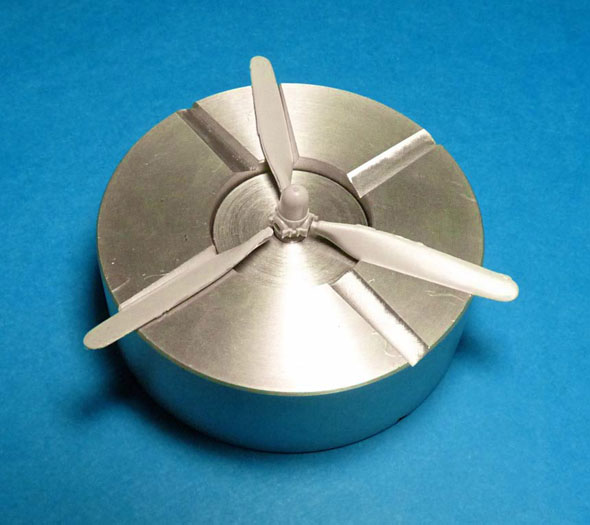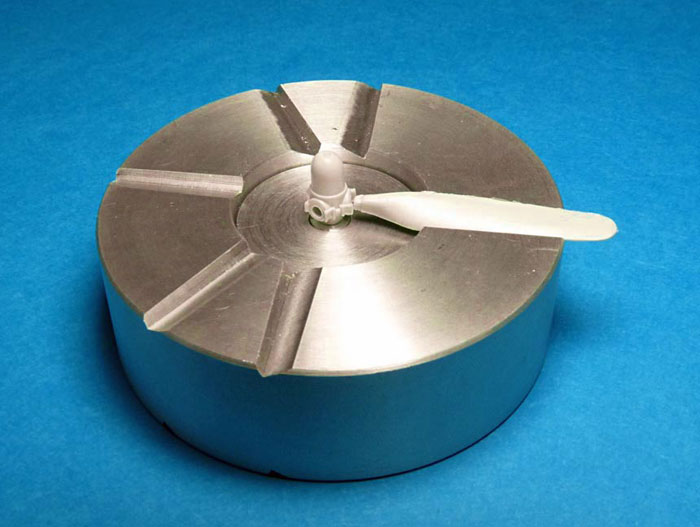You’re just about to start to assemble that resin prop you spent a chunk of change on, or the one that came in that awfully expensive resin kit. You’ve got the hub/spinner, the blades, 2, 3 or 4, and the CA (super) glue. Now the challenge is to attach all those blades perpendicular to the axis of the spinner, at the same pitch and spaced evenly at the correct angle between blades.
You have also discovered that you were not blessed with three hands and your spouse has no idea what you are doing and cannot seem to follow simple instructions about the pitch and angle and how much glue to apply. This is compounded by the fact that anyone of the blades could, and most likely will, have the glue set up when the blade is at the wrong position or angle. The most likely final outcome of all this is that a fragile resin prop blade has become firmly bonded to your or your spouse’s ……… (name the body part).

I can guess that only a person who has gone through this enough times and has become totally frustrated would have thought up the PropMaster. As with all good things, so obvious, so simple and it would actually appear to work.
Describing the PropMaster could be more complicated than actually using it. For the 1/48 version, it is a hefty, machined disc of aluminum approximately 2.75 inches (69.85 mm) in diameter and approximately .75 inches (19.05 mm) thick.
On each side are machined grooves at the positions for a two, three or four bladed prop. The grooves are machined at an angle to represent the pitch of the blade. On one side the pitch is set for a clockwise rotating prop and on the other side the pitch is set for a counter-clockwise rotating prop.
In the center is an adjustable platform with a well in the center and a screw head on the backside. By turning the screw, one adjusts the height of the platform. The easiest way to remove the platform and turn it over to change from clockwise to counter-clockwise props is to hold the platform and screw head between thumb and index finger and spin the base.
The PropMaster comes with five little inserts that fit within the well of the platform. Each insert has a hole in the center of a different diameter to accommodate the shaft of the hub/spinner. But care must be taken here, for I found that the shaft on my Obscureco 1/48 Hamilton Standard Prop was slightly too big for one insert and slightly too small for another. Since there is only a small base on the prop hub, I will need to be aware of possible wobble, and act accordingly. For a larger spinner arrangement with a broad base, the exact fit of the shaft into the insert will not be as critical.

Now that all that is clear, lets set up a prop blade for assembly. First determine which side to use for the prop rotation. Then drop the hub/spinner shaft into the appropriate size insert and set the insert into the platform.
Next place a blade into one of the appropriate grooves for your prop with the leading edge slanted up. By holding the side of the platform between thumb and index finger, you turn the screw on the underside with your other hand to raise or lower the platform in order to align the base of the blade with the opening, or location, on the hub. Once this is done, set in the remaining blades and one by one glue and attach the blades to the hub/spinner.
If you actually had done that, you would have probably assembled three props in the time in which it took to read this.
Now the instructions indicate that you can set the pitch of the blade by using the PropMaster, but I’m not sure how this could be done, other than by simply holding the blade at a pitch you want while the glue sets. All the grooves appear to me to be at the same pitch.
The PropMaster seems an eminently easier method of assembling a prop than holding the parts in one’s shaky hand and eyeballing perpendicularity, angle and pitch, all while applying glue.
Even in this day when medical reconstruction can be done, $28 for the PropMaster is a lot cheaper and less painful than grafting on a third forearm and hand, not to mention the cost of a divorce lawyer.
Thanks to John Vojtech of UMM-USA for the review sample.
